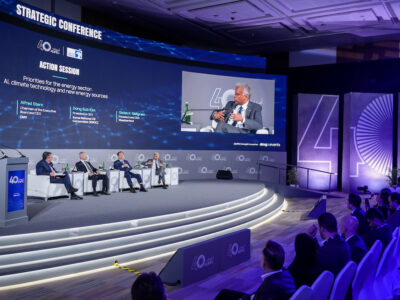Ericsson gave a thorough overview of the next phase of 5G at this year’s LEAP tech conference in Riyadh, which goes far beyond merely higher mobile connections. The massive Swedish telecom company is exhibiting a variety of future services and apps enabled by 5G networks, including as cloud gaming streaming with little latency and immersive sports experiences through augmented reality.
Most importantly, though, may be the new network exposure capabilities that Ericsson is introducing. These might completely change how mobile applications and services take advantage of 5G’s very high bandwidth, ultra-low latency, and enhanced connectivity.
“The infrastructure had to be built in the first phase of 5G. The new experiences and services that infrastructure can provide are now being showcased,” Ekow Nelson, who oversees Ericsson’s operations in Pakistan and the Etisalat Group, said.

Immersion media becomes the main event
At Ericsson’s exhibition area, the “immersive sports” demonstration is one of the main attractions. Enter a 360-degree virtual arena where augmented reality superimposes real-time data visualizations, statistics, and telemetry over the court or playing field. It offers a glimpse into how 5G can enable fans to enjoy next-generation media experiences.
Additionally, Ericsson is showcasing the high bandwidth and low latency of 5G, which enable extended reality (XR) experiences. According to Nelson, “Using 5G technology, we can deliver new experiences through extended reality and the new glasses like Vision Pro that will allow you to step into a different world.”
The demonstrations of holographic video calling, which use photoreal 3D avatars to enable remote contact in a whole new way, are possibly even more innovative. “You’ll be able to see a 3D image of the person you are communicating with,” Nelson explained.
However, the collection that is most likely to strike a chord with customers is the cloud gaming demonstration that Ericsson and a local telecom operator put together. By enabling multi-user cloud gaming to be transmitted over the mobile network without noticeable lag, it demonstrates 5G’s extremely low latency. This is an important use case as cloud gaming keeps becoming more and more popular.
Unlocking the potential of network intelligence
Although those customer experiences are indeed remarkable, Nelson believes that allowing developers to access 5G networks’ cognitive capabilities through APIs and network exposure functions could be the biggest game-changer. The goal of Ericsson’s platform is to make 5G network services available for apps to use, such as quality-on-demand, quiet authentication, and position monitoring.
“Developers can build applications that would utilize the capabilities of the 5G network,” Nelson said. “We believe this is going to be a big game changer, because we expose the capabilities and then leave it to the creative imagination of developers to build applications we cannot think of.”
He gave instances such as how network knowledge about device location and status combined with user sign-in attempts could improve fraud detection for banks. Beyond what the phone’s operating system location services provide, ridesharing apps may have access to more precise location data or offering bandwidth that is temporarily prioritized for premium app experiences.
“One bank in Egypt is looking at if you go to withdraw money from an ATM while roaming, they want to know your device status and location as part of fraud detection,” Nelson stated. “They want to be able to verify you are actually in that country by tracking your mobile device location.”
Finding a happy medium with privacy
However, there are privacy concerns over data sharing and user consent with this new paradigm of apps interacting more directly with mobile networks. Nelson agreed that as the lines between network operators’ and app developers’ duties blur, protections like opt-in controls and regulatory monitoring will probably be required.
“Many of these will need to be able to opt in. For this to be carried out, you must be allowed to opt-in,” Nelson said. “Security is an important part…and in some jurisdictions, regulators might say they need a popup to specifically ask permission.”
Leveraging all of 5G’s features
The Gulf countries have led the way in the rollout of 5G, with Saudi Arabia reaching over 90% population coverage by 2020 as a result of strong government support. Nelson notes that some markets’ treatment of 5G infrastructure as a public utility rather than as a means of earning revenue through spectrum auctions is a significant contributing element.
Regarding spectrum and license regulations, he stated, “In certain countries, they are encouraging investment in building out the network as opposed to prohibitive extraction of money as an operator.” “If you do business in local currency but have to pay for spectrum in foreign currency when that local currency devalues, it’s really hard for operators.”
Although 5G non-standalone modes served as a temporary solution initially, Nelson claims that the area is quickly moving toward full 5G standalone, which will enable the new networking paradigm to realize its full potential. This year, more 5G data traffic than 4G data traffic is anticipated in the UAE, with Saudi Arabia following suit in 2024.
However, the main opportunity extends beyond simply upgrading current services and apps to a faster conduit. It involves re-evaluating experiences in their entirety.

“We don’t want to use the 5G network for exactly what we used 4G networks for,” Nelson said. “The question is, what else can we use the new network capabilities for beyond being faster?”
The key to opening up new applications that looked unattainable a few years ago is to expose these next-generation network capabilities as Ericsson develops its 5G radio, core, and cloud native infrastructure. Although futuristic consumer services are often the focus of media attention, Nelson believes that the commercial space may provide an even greater initial frontier, encompassing digital twin simulations, intelligent logistics, industrial automation, and more.
“Part of what we’re showing is our Vonage APIs and global network platform to expose things like network location, quality-on-demand and other capabilities for application providers and developers to build on top of.”
It will be difficult to strike a balance between security and privacy as we transition to a single app-network model. However, the next phase of 5G is about much more than just speed, as demonstrated by Ericsson’s LEAP presentation. It involves bringing the digital and real worlds together by unfolding an app-assisted fabric.
Brand View allows our business partners to share content with Arabian Business readers.
The content is supplied by Arabian Business Brand View Partners.








